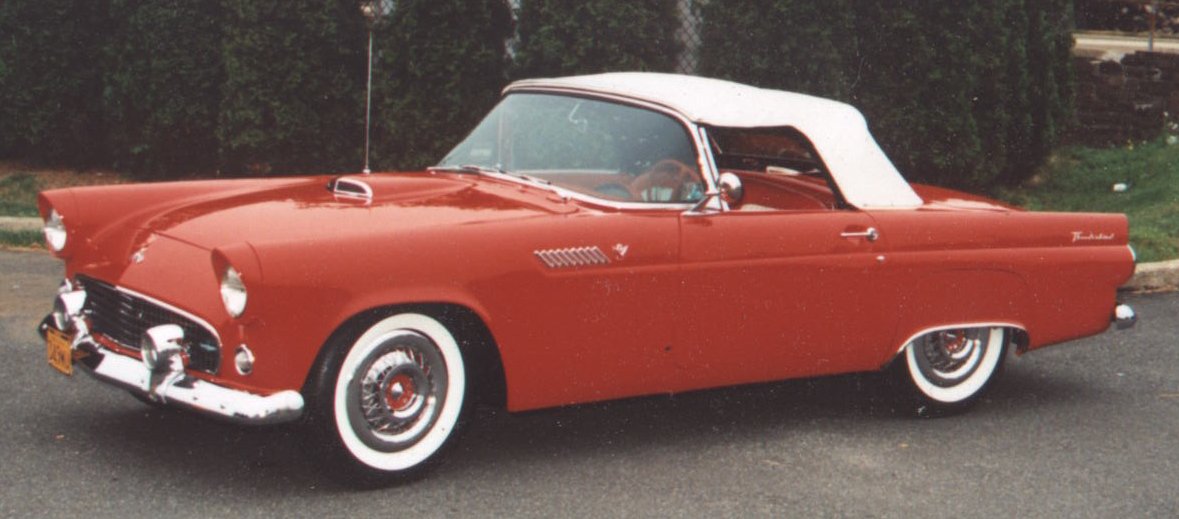Classic Thunderbird Radio Info
The radios for the little ‘Birds (1955-1957) were all manufactured by Motorola. Other Ford vehicle radios were manufactured by Bendix as well as Motorola. The model number for these (and most other Ford radios) can be found on the left-hand side, while facing the radio. The ’55 number begins with 5MFS or 5MFS8, followed by four or five digits to make up the serial number. The 5 signifies the year of manufacture while the M is for Motorola, F is for Ford and S is for sports car. The 8 represents the number of tubes in the radio. One of the peculiarities of this radio (and the 56 and 57 T’bird) is that the on/off switch is not on the volume control but controlled by a push button. Of course this switch, being unique, is difficult to buy and typically fails (Murphy’s law). The radio operates from 6 volts. Although designed for a positive ground car, it was not polarity sensitive. However, with the advent of solid state vibrators, that is no longer the case. The original vibrators were electro mechanical and their short life was responsible for an increase in the revenue of repair shops in that era. Today the solid state vibrator has eliminated that problem. When I repair a radio with a vibrator, it gets the new solid state version whether it has failed or not. A 1954 Ford passenger car radio exists that is very close in appearance to the T’bird but it has black plastic buttons and the face is slightly different.
Ford went to the twelve volt system in 1956. This required a redesign of the traditional radio but it remained functionally the same. The Town and Country option was introduced that year by Motorola that was a signal seeker, much like today's car radios, except that it was mechanical with it's eccentricities. When either bar was depressed a motor was engaged that tuned the radio until it found a suitably strong radio station. The Town bar caused the radio to only stop at strong stations while the Country bar stopped at weak ones as well. When the search function reached the end of the dial, it reversed direction. (The Delco signal seeker only tuned in one direction. It went back to the top of the dial and started over.) The Town and Country option was offered on Motorola radios on both passenger cars as well as Thunderbird. The passenger car radios were designated 69MF and the T’bird radio was designated 69MS. The passenger car radio had square buttons while the T’bird retained the round buttons of the ’55 T’bird. Besides the on/off button, the ’56 had a transformer weakness. The 1955 was potted but the ’56 was open frame. This left it prone to contamination.
In 1957 the tube manufacturers were feeling the heat (no pun intended) from transistors. Transistors worked with 12 volts but tubes required higher voltages which necessitated vibrators and transformers and their circuitry. This added significant cost to the radio. A radio that used only transistors would have a real cost advantage. To combat this the tube manufacturers created a tube that worked directly from 12 volts, eliminating vibrators, etc. This only postponed the inevitable supremacy of transistors but it gave the ’57 T’bird radio a nice advantage over the ’56 and had the signal seek option as well. A common misconception is that the two transistors on the rear heat sink were the power supply. They are actually for the audio amplifier. The passenger car radios were designated 79MF and the T’bird radio was designated 79MS. A short lived option only on the ’57 Thunderbird was the speed compensated volume control. The idea was to increase the radio volume automatically with speed (road noise). To do this the designers got a signal from the distributor (RPM) and used it to proportionately increase the volume. Most ’57 owners don’t even know they have the option and it is seldom implemented. Well intentioned mechanics disconnect it because they fear it can impede starting. Not true, and all ’57 T’bird radios that I repair have that capability restored.
© Copyright 2007-2008














